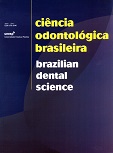Clinical evaluation of the topical use of propolis in recurrent minor aphthous ulceration
DOI:
https://doi.org/10.14295/bds.2005.v8i3.327Abstract
Our purpose was to evaluate the therapeutic effects of a natural product (propolis) on recurrent aphthous ulceration (RAU) of the minor type regarding the number of lesions, their duration and frequency of recurrence. Seventy patients with RAU composed the study group who were examined according to pre-established criteria. Forty patients presenting with RAU (mean age 38.5 years; 25 women and 15 men) were selected and medicated during the recurrence of their lesions using a purified propolis solution in a 5%propyleneglycol vehicle. Patients applied the topical solution three times a day from the first premonitory sign of RAU appearance and also during episodes of recurrence for a period of one year. A statistically significant reduction was observed in the number, frequency and duration of the lesions (p≤ 0.01). The natural propolis product utilized in this study for RAU therapy was without any adverse effects and proved beneficial.Downloads
Downloads
Published
How to Cite
Issue
Section
License
Brazilian Dental Science uses the Creative Commons (CC-BY 4.0) license, thus preserving the integrity of articles in an open access environment. The journal allows the author to retain publishing rights without restrictions.
=================




























